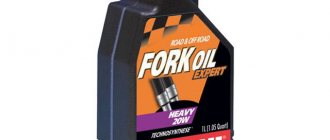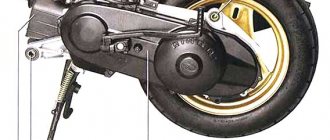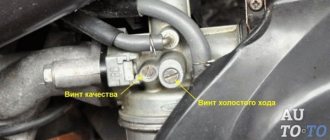Scooter rider
Everyone who takes the path of a motorbike enthusiast is faced with the problem of choosing and changing oil for a scooter or motorcycle. While some people change it immediately after purchase, others travel several thousand kilometers and only then change the oil. But there are also those who do not change it at all; this, of course, does not last long. To choose which oil is suitable for your scooter, you need to know the type of engine of your scooter. There are two-stroke (2t) and four-stroke (4t) scooters. Accordingly, there is oil for 2t and 4t scooters. For each of them there are three types of oil: mineral, synthetic and semi-synthetic. Let's decide on the type of oil that suits your scooter. To do this, determine the type of engine: two-stroke or four-stroke. After this, you can start making your selection.
Semi-synthetic and mineral oils
Such motor and transmission oils are used along with synthetic ones for two main reasons:
- The price of such oils is slightly lower than that of synthetic ones.
- With some wear, the engine requires a more viscous oil and in this case semi-synthetic and mineral oils are most suitable. Therefore, when looking for an answer to the question of what kind of oil to pour into a scooter whose engine has been running for a long time, preference should be given to semi-synthetic and mineral oils.
Scooter owners are often concerned with the question: is it possible to pour car oil into a scooter ? Manufacturers strongly do not recommend making such a replacement, since oil intended for motor vehicles is somewhat different from special motor oil. But at the same time, many scooter owners claim that they use automobile oil in the engines of their two-wheeled friends quite successfully. Therefore, it is impossible to unequivocally answer the question “is it possible to pour car oil into a scooter,” but it is better not to risk it and use the oil recommended by the manufacturer in the scooter.
Scooter with four stroke engine
For scooters with a regular gearbox, 4t oil is suitable, but if your scooter has a CVT gearbox, then you need gear oil. In the case of a 4t scooter, the choice of oil comes down to the same principle as for a 2t. That is, it all depends on the riding style, the technical condition of the moped and also its age. If we talk about four-stroke mopeds, then it is recommended to fill them with 10w-40 oil. In principle, a moped can run on regular car oil, but use such oil at your own peril and risk. The oil must protect all rubbing parts well, and there are a large number of them in the engine. And the scooter clutch especially needs high-quality oil, since it literally floats in oil.
If we are talking about what kind of oil to pour into cubic capacity motorcycles, then two-stroke synthetic is better. This way the cylinder-piston group will remain clean and well preserved. This oil is the most resistant to various temperatures. Also, synthetic scooter oil produces less soot, which settles in the muffler and clogs it.
Why change the oil
I met a person who did not change the oil for 3 seasons. His ATV was being repaired and there was little left of the oil, everything was covered in soot. And the engine was working in this one, it’s good that it was still working at all. But it significantly reduced its service life, and the repairs cost a pretty penny.
As mentioned, a good synthetic oil prevents the formation of carbon deposits and is resistant to temperatures. Carbon deposits interfere with engine operation and reduce its service life, complicate the life of compression rings and cause overheating. And given that the amount of carbon deposits is constantly increasing, plus constant overheating, repairs will not take long. And expensive motorcycles require expensive repairs. Therefore, it is not recommended to skimp on oil.
And what will happen if you don’t change the oil, you will find out from the video:
How much oil to put in a scooter
Each scooter needs a different amount of oil. But using the golden rule this can be easily understood. After all the oil has been drained from the crankcase, you need to measure how much of it came out and then fill in the same amount plus 3-5 percent. If the scooter is new, then you don’t have to add 3-5%, and fill in as much as you drain.
Source
Scooter with two-stroke engine
If the scooter engine is two-stroke, then the oil for it must be 2 tons. This type of scooter eats oil and is added in small doses to gasoline (in modern 2T scooters, oil is no longer diluted with gasoline thanks to a separate engine lubrication system). Therefore, the oil must be such that it mixes well with gasoline and does not settle at the bottom and clog the carburetor. 2t oil copes well with this.
What kind of oil to pour into a 2T scooter depends on your riding style. If you drive slowly around the city or on the highway, then semi-synthetic and mineral oil are suitable for you. But if you have severe frosts and bad weather conditions, or you are always moving at full throttle, then you need synthetic oil. It does not change its properties down to -35C. Of course, under such conditions it is not recommended to ride a scooter; in this case, a car would be more suitable. It is recommended to fill a scooter with a two-stroke engine with oil from the following manufacturers:
- Motul
- Mol Dynamic
- Castrol Power
- Castrol Act Evo
- Repsol Moto (Sintetico 2t, Off Road 2t, Racing 2t, Competicion 2T)
- And other quality oils.
Four-stroke scooter oil - tips and tricks for use
The choice of four-stroke oil should be approached with the same attention as the choice of CPG elements and other scooter parts, and in some cases, with even greater responsibility.
The service life of the scooter or individual engine parts directly depends on the quality of the oil, as well as on the quality of the running-in. You cannot choose oil for a four-stroke scooter based only on material considerations. In this case, the savings later turn into expensive repairs, where you sometimes have to pay an order of magnitude more. The basic rule is to select proven lubricants of the nominal value specified by the scooter manufacturer. Advice from friends and store clerks will be superfluous here. It’s better to overpay and be confident in the quality of the oil than to buy something outright cheap on the advice of friends and expect a breakdown at any moment.
What kind of oil is poured into a scooter?
Motor oil plays a huge role for any engine, so the choice of oil should be in accordance with all the requirements of the scooter. The future operation of the engine, its wear and other characteristics depend on the choice of oil. But today scooters are classified by manufacturer, namely Chinese and Japanese. Accordingly, Chinese models have a 4-stroke engine, while Japanese ones have a 2-stroke design. This is precisely the first key point that you need to pay attention to when choosing oil.
Any novice scooter rider will be faced with the choice of oil for a scooter; many pay attention to such indicators as:
Deciding on the first point is quite simple; the oil label always says which scooter (2t or 4t) it is intended for. The second point also plays an important role, because cheap motor oil will have a poor composition, viscosity and will not cope with proper cooling and lubrication of the engine. The third point (type of oil) says that regardless of the type of your engine, manufacturers distinguish three types of motor oil for scooters - synthetic, semi-synthetic and mineral. Let's consider each point in order.
The best type of oil is synthetic, it provides better engine protection and is offered at a higher price. According to its characteristics, synthetics are considered a less viscous substance; the viscosity does not change during operation, for example, when a scooter overheats, the viscosity does not deteriorate. At elevated temperatures, synthetic oil does not become liquid; too cold weather does not allow the oil to become thick. As a rule, many manufacturers offer oil in several types.
The semi-synthetic type is a cross between synthetic and mineral oil. This oil has a very affordable price and is intended for motorcycle equipment that is quite old. Also, semi-synthetics have an average viscosity, which ranges from 10 to 40 w.
Mineral oil is considered the cheapest and lowest quality, because it is used more often in Chinese scooters, which do not require special care and have a simple, unpretentious engine. Mineral oil is also intended for equipment that is operated under special conditions.
Two-stroke oil . Designed for 2 stroke engines. This type differs from 4t oils in that it has different characteristics. It contains special additives that produce less smoke and ash content. The second difference of this type is the ability to fill oil only into a special oil tank. The excellent characteristics of 2 tons of oil allow it to penetrate gasoline and the crankshaft crankcase, after which the liquid in the form of oil + gasoline perfectly lubricates most engine parts. After this, the oil burns together with gasoline. Experts do not recommend putting 4t oil in a 2t scooter; this can lead to increased carbon deposits, faster engine wear and increased smoke from the exhaust pipe.
Changing engine oil
Draining used oil
We place the scooter on the center stand; if it is crooked, we straighten it. On the left side in the direction of travel of the scooter, at the very bottom of the engine, look for the drain plug, place a previously prepared container under the plug and unscrew the drain plug with a 17mm head.
While the oil is draining, go to the right side of the scooter and unscrew the dipstick and the oil filter plug, which is located at the very bottom of the engine.
We put a good 17 socket on the plug, unscrew it and remove it with all its contents from the engine.
This is the oil filter. Immediately after unscrewing it, while the point is still important - throw all this junk into clean gasoline, give it a good shake, and then blow it out and dry it.
After the oil filter plug is removed from the engine. In order to remove any remaining oil from the engine, pump the engine several times using the kickstarter.
Then we wait about five minutes - wipe the drain holes dry, for greater reliability, apply sealant to the plugs and screw them into place.
Filling the engine with new oil and checking its level
Depending on the design of the canister, pour oil into the neck either directly from the canister itself or through a funnel. The funnel must be clean!
Oil level control
The oil level is checked as follows: pour the first portion of oil into the engine, approximately 600-700 ml, wait a couple of minutes until the oil spreads evenly over the crankcase without twisting, insert the dipstick all the way into the filler neck, remove it and check the level.
The oil level must be within the control area.
- If the level is lower, add a little oil, wait a couple of minutes and take a measurement.
- If the oil level is higher than normal, drain it or, better yet, pump it out using a syringe with a tube from the neck.
The control area is indicated by red arrows. In my case, the oil level is exactly in the middle of the control section and is indicated by a blue arrow. Ideally, the oil level should be near the upper boundary of the control section. But this is ideal, but in practice, the average level is quite acceptable and does not in any way affect the reliability and durability of the engine.
What oils to use for scooters
Full technical operation of motor vehicles, which fully includes the widespread scooters, largely depends on the lubricants used. When wondering what kind of oil to pour into a scooter, you should have a full understanding of an important point: two main components of the unit need liquid lubrication - the power plant and the gear transmission system.
Lubricants, which are designed to ensure the performance of the engine and gearbox, have completely different component compositions, viscosity indicators and other important physical and technical characteristics.
Transmission lubricants
In modern scooters it is already difficult to find a gearbox in its traditional sense - with manual mechanical shifting. Regulation of the speed transmitted by the engine to the wheels is carried out by CVTs of various designs. The CVT scheme involves the integration of two or three-stage reduction gearboxes into the transmission of scooters.
Again, taking into account the predominantly summer operation of motorcycles, it is better to pour oil of more viscous modifications into the scooter. The most widely used transmission liquid lubricants are 80W90 or 75W90, although it is safer to check the recommended viscosity values in the scooter’s passport documentation.
It is better not to use additional additives - high-quality transmission oils are produced with a full range of additives necessary to ensure effective lubrication of gears, which have been tested for compatibility with the base oil.
Lubricants for scooter powertrain
Scooter engines, which originally had only a two-stroke design, in modern cars have invariant operating principles. Mobile urban transport is increasingly equipped with four-stroke engines, especially for vehicles manufactured in China.
The principle of lubrication of the bearing supports of the crankshaft and the cylinder-piston group, as is known, is fundamentally different in engines with two and four strokes. Accordingly, there are significant differences in the oils that should be used.
A closed system for lubrication of the rubbing elements of a four-stroke engine involves the use of lubricants whose physical and technical properties ensure a long service life without loss of their basic properties. In scooters with two-stroke engines, on the contrary, good performance results are provided by oils that can burn in the combustion chamber of the internal combustion engine without the formation of excess amounts of soot components. The combustion of oil, among other things, should not be accompanied by excessive smoke.
Lubrication of four-stroke engines
The first and most important caveat regarding lubrication for four-stroke engines may sound trivial: motor oil for a scooter should be used that is recommended by the engine manufacturer. There is one important nuance in this truism: very common Chinese-made cars are equipped with engines whose manufacturers are located far beyond the borders of the Middle Kingdom.
There are motors that were discontinued in Japan or the USA 10–15 years ago, Korean-made power plants, and others. It seems difficult to find exotic products from ten years ago in the constantly updated range of lubricants. The question naturally arises - what kind of oil to pour into a scooter whose engine is recommended to have a lubricant that no longer exists.
In such cases, a simple rule of thumb follows. The oil must ensure the creation of a reliable separating film under the conditions that accompany the operation of the power plant. Conditions include:
Scooters are used mainly in the warm season. Accordingly, the viscosity that the lubricant being poured must have must ensure that its properties are maintained exclusively at positive or slightly negative outside temperatures. According to the SAE classification, these classes include oils of the 5W30, 10W40 and 10W50 classes. These are the lubricants that are recommended for use in four-stroke scooter engines by major manufacturers and experienced users.
Lubrication of two-stroke internal combustion engines
Scooter two-stroke powerplants can be lubricated in two ways. One of the methods is lubrication, traditional for most engines of this type, with oil initially dissolved in gasoline.
Modern engines are equipped with separate injection of oil and fuel into the space behind the carburetor. The second method is much more rational. In addition to reducing lubricant consumption, the engine operates under more favorable combustion conditions for the fuel mixture. At idle speed, the proportion of the oil-fuel mixture can reach 1:200.
Under any conditions, oil marked with the 2T index should be used to lubricate the cavities and rubbing surfaces of a two-stroke internal combustion engine. Separate supply of oil and fuel requires instant and high-quality mixing of the components. In this case, it is advisable to use lubricants marked “self mix”, which means independent and quick mixing with the gasoline-air mixture.
According to the API classification, lubricant should be selected in TA or TV classes - they are intended specifically for use in two-stroke engines of scooters, mopeds and garden equipment. Smoke emission is classified by the Japanese JASO standard, which implies division into classes from FA to FD. The most smokeless of them is represented by class FD.
Why is fresh scooter gear oil necessary?
One of the most important components of a scooter can rightly be called the gearbox. It is responsible for timely reducing the speed of the driven shaft, thereby increasing torque. That is, it converts high shaft and clutch speeds into fairly powerful, but low wheel speeds. This part consists of a number of rubbing elements (gears and bearings) that undergo enormous loads, and, as expected, they need good care. It is the transmission oil that provides such care.
It is an oil doped with various functional additives. The main function of transmission fluids can be called protective, as they protect the surface from wear, corrosion, seizing, etc. In addition, thanks to them, energy losses are reduced and heat removal from friction surfaces is ensured. Shock loads, vibrations and noise in gear drives are also significantly reduced.
Motor oil for scooter
Modern motorcycle equipment is equipped with two types of internal combustion engines: two- and four-stroke power units. Therefore, when choosing motor oil for a scooter, you need to be guided not only by the popularity of the technical fluid manufacturer, but also take into account the performance characteristics of the model, as well as the manufacturer’s recommendations.
Types of oils
Lubricating fluids are designed to reduce wear of contacting surfaces and reduce energy efforts to overcome friction forces. In addition, the materials form a durable oil film in the contact areas, which helps remove heat from engine parts, seals working components and protects the internal surfaces of the cylinder block from corrosion.
The properties of oils depend on the technical characteristics of the base and the chemical composition of modifying additives that are introduced into liquids to improve their performance parameters. The basic components of oils are divided into several categories:
Synthetics
Synthetic motor oils are produced by the synthesis of hydrocarbon organic substances. Polyalphaolefins or ester derivatives are used as base components for the production of technical fluids. Chemical processing and subsequent purification of raw materials make it possible to obtain high performance properties of the mixtures:
Due to their high thermal properties and low oxidizing ability, synthetic oils perform well in air-cooled two-stroke gasoline engines. Their use makes it possible to reduce the smoke of exhaust gases and minimize the formation of soot on the cylinder walls.
Mineral petroleum products
Mineral oils are products of direct distillation of petroleum. The quality of lubricants depends on the method and depth of purification of raw materials. To give the base components the recommended performance properties, modifying additives are introduced into the base of technical fluids. The composition of the package and the amount of chemicals is determined by the conditions of use of motorcycle equipment.
Mineral lubricants are cheaper than synthetics and semi-synthetics, but due to the ability to quickly burn with the formation of carbon deposits, a two-stroke scooter engine must be washed and cleaned frequently. For this reason, the resulting savings are offset by labor costs for frequent maintenance.
Semi-synthetics
Semi-synthetic oils are an intermediate option between the previous types of liquids. The basis of the structure is mineral components, which contain 20–40% synthetics. Synthetic additives ensure easy starting of a cold engine, protect parts from premature wear, and clean the engine well from combustion products. The materials are used to lubricate any type of engine, except for high-performance models operating in extreme conditions. In mopeds with a two-stroke engine, semi-synthetic oils increase engine life and reduce the likelihood of carbon deposits.
Scooter gearbox - design and principle of operation, oil change
The article describes the design and operating principle of a scooter gearbox .
What is a gearbox? A gearbox is a set of gears housed in one common housing called a crankcase. The presence of a crankcase allows for compact arrangement of gear parts, protects parts from mechanical damage and contamination, and provides the necessary lubrication.
What is a gearbox used for? And it is needed to change the speed of rotation of the shafts, down or up.
Gearboxes are installed on all scooters between the output shaft of the automatic centrifugal clutch (read an article about it here) and the wheel.
Figure 1 shows the entire powertrain of the scooter. Circled in red is the gearbox housing 1 with a block of gears 2, 3 and 4. This gearbox is of the two-stage cylindrical gear type, has a fairly high gear ratio and reduces the speed of shaft 4 with wheel 5 several times, while increasing the traction force almost as many times .
And now about the device. On the primary shaft 2 of the gearbox there is a driven pulley of the variator and a centrifugal clutch, and torque from them is transmitted to the same shaft. Next, the torque is transmitted to the intermediate shaft with the gear block 3 and then to the secondary shaft 4 on which the wheel 5 is located. The required amount of engine* (note the article is saved in its original form, but transmission oil is poured into the gearbox) oil for lubrication is poured into the crankcase 1 gears
There are also gearboxes that are of the single-stage cylindrical gear type. The principle of construction of such a gearbox is shown in Figure 2. In it, in the crankcase 1, there are only two shafts instead of the three described above: primary 2 and secondary 3. On the secondary shaft 3 there is a wheel.
Also, in all gearbox housings there is a hole for simultaneously filling and draining oil. Some models have a separate oil drain hole located at the bottom of the crankcase. The role of the filler plug is performed by a simple bolt and washer. The amount (volume) of oil to be poured is often written on the crankcase itself, not far from the plug, and generally for 49 cm3 scooters it is 90-100 grams.
Once a season , check the presence of oil in the crankcase . In the absence of oil or its low level, an unpleasant hum begins to appear on the side of the gearbox, which leads to rapid wear of bearings and bushings.
Choosing scooter oil
When purchasing an oil fluid, you need to focus on the viscosity recommended by the manufacturer, taking into account the temperature indicators of the region of use (seasonality). Lubricant mixtures for scooters are usually systematized according to the type of engine for which they are intended to operate.
The limitations are caused by the fundamental difference in the lubrication systems of two- and four-stroke engines. Therefore, when choosing oil for a moped, you must strictly follow the operating instructions and focus on the individual characteristics of the existing model.
Two stroke engine
Two-stroke engines installed on scooters are lubricated with oil fluids, which are first mixed with fuel and then burned in the cylinders along with it. Hence the specific requirements for this group of oils:
Special brands of oils for two-stroke engines:
Scooter with four-stroke engine
Oil for scooters with a four-stroke engine is designed to work in difficult operating conditions. This is due to complex city traffic, where there are frequent stops, alternating driving modes, sudden acceleration, etc.
The specificity of engine lubrication is that some parts are lubricated under pressure using an oil pump - these are the main bearings, the crankshaft and the cylinder head. The remaining rubbing surfaces are washed by spraying or oil mist.
Scooter gearbox
The job of a scooter gearbox is to transmit rotation from the driven pulley of the variator to the rear wheel. The first gear ratio goes straight through the CVT. The CVT reaches its final ratio (the belt in front goes to the outer radius) by rotating the driven pulley about 5 times per crankshaft rotation (at 10,000 engine rpm, so 50,000 pulley rotations). Presumably, if the wheel were sitting on a driven pulley, then the wheel would have to make 5 full rotations with each ignition (corresponding to the rotation of the crankshaft). The result would be such a long ratio that the motor would not be able to pull. Thus, the importance of the gearbox becomes obvious: by transmitting torque from the driven pulley to the rear wheel, it reduces the rotation speed. How many times? On different scooter models this number may differ slightly, but it is always close to 12, for example on the Yamaha Aerox, to be precise, 12.28, and on the Chinese Baotian Tanco 50 about 11.3. This means that for one revolution of the rear wheel there are 12.28 and 11.3 revolutions of the driven pulley, respectively.
The gearbox gears are located in a closed container at the rear of the scooter housing. The container is filled with oil, so the oil must be drained before opening the lid.
The scooter's gearbox mechanism is divided into primary (gears 1 and 2) and secondary (gears 3 and 4) gears. Primary or secondary gears always consist of two gears - large and small. By dividing the number of teeth on the drive gear by the number of teeth on the driven gear, we obtain the gear ratio. For example, the small and large primary gears (1 and 2) of the Yamaha Aerox have 13 and 52 teeth, respectively. It is clear that the drive in this case is the small gear, so the gear ratio will be equal to 13/52, or 1:4 if we divide the numerator and denominator by 13. For us, this means that for every four revolutions of the drive (small) gear there is only one slave revolution (large). Knowing the sizes of the secondary gears (3 and 4) of the same Yamaha Aerox - 14 and 43 and acting in a similar way, we obtain a ratio of 1: 3.07. Now all that remains is to multiply the resulting ratios 1:4 and 1:3.07 to get the final ratio of the Aerox gearbox 1:12.28 - it was mentioned at the very beginning.
The lower the gear ratio, the longer the transmission. For example (for primary gear), 1:4.2 - short gear; 1:3.15 - medium gear; 1:2.73 - long pass; 1:2.11 - very long pass.
It makes absolutely no difference which gear - primary or secondary - is used to change the final ratio of the gearbox. On scooters prepared for competitions based on High-End piston engines, sometimes even both gears are replaced.











